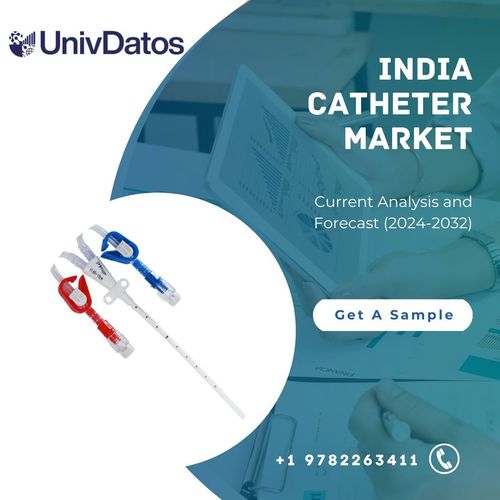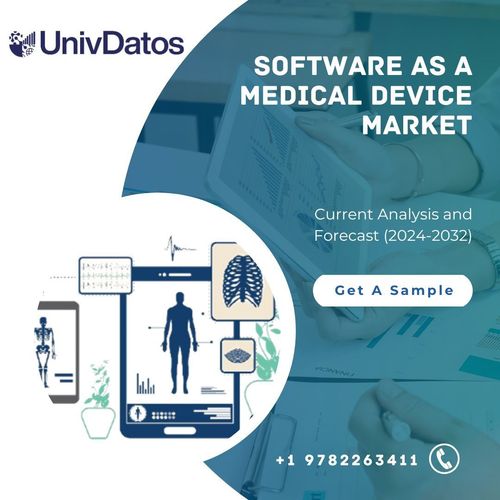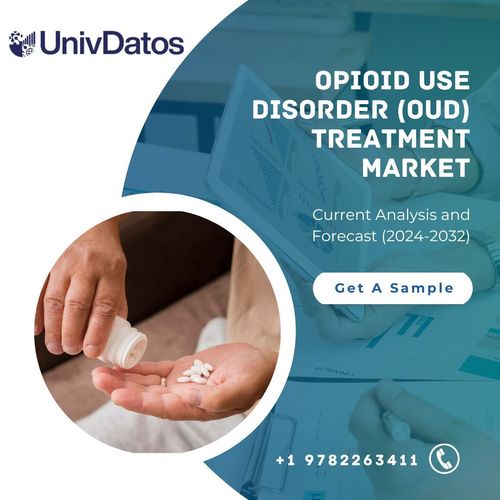Pulmonary Arterial Hypertension Market: Current Analysis and Forecast (2024-2032)
Emphasis on Type (Branded and Generics); Drug Class (Endothelin Receptor Antagonists (ERAs), PDE-5 Inhibitors, Prostacyclin and Prostacyclin Analogs, and SGC Stimulators), Distribution Channel (Hospital Pharmacy, Retail Pharmacy, and Online Pharmacy); and Region/Country
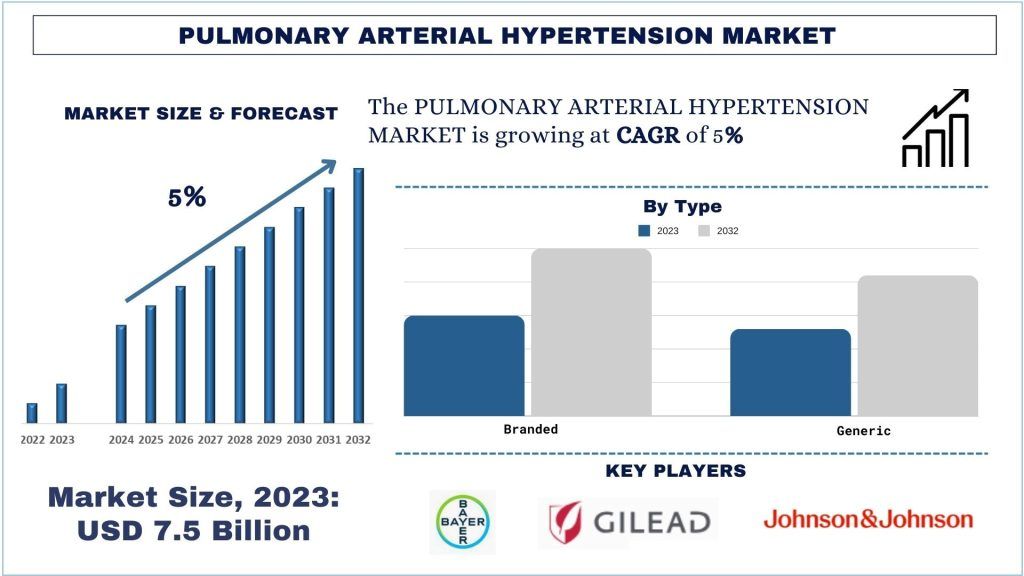
Pulmonary Arterial Hypertension Market Size & Forecast
The Pulmonary Arterial Hypertension Market was valued at approximately USD 7.5 Billion in 2023 and is expected to grow at a strong CAGR of around 5% during the forecast period (2024-2032) owing to the rising cases of PAH.
Pulmonary Arterial Hypertension Market Analysis
Pulmonary Arterial Hypertension (PAH) is a rare and progressive disorder characterized by high blood pressure in the pulmonary arteries, which carry blood from the heart to the lungs. This condition leads to the narrowing and stiffening of these arteries, causing increased resistance to blood flow and subsequently putting extra strain on the right side of the heart. Over time, PAH can result in right heart failure and other severe complications. Symptoms typically include shortness of breath, fatigue, chest pain, dizziness, and swelling in the legs and ankles. PAH can be idiopathic, heritable, or associated with other diseases such as connective tissue disorders, congenital heart disease, or chronic liver disease. The increasing incidence of PAH is driving the market. For instance, as per the data of American Heart Association (AHA) 2021, the prevalence of PAH in the United States is estimated to be between 15 and 50 cases per million people, with an incidence of about 2-5 cases per million adults annually.
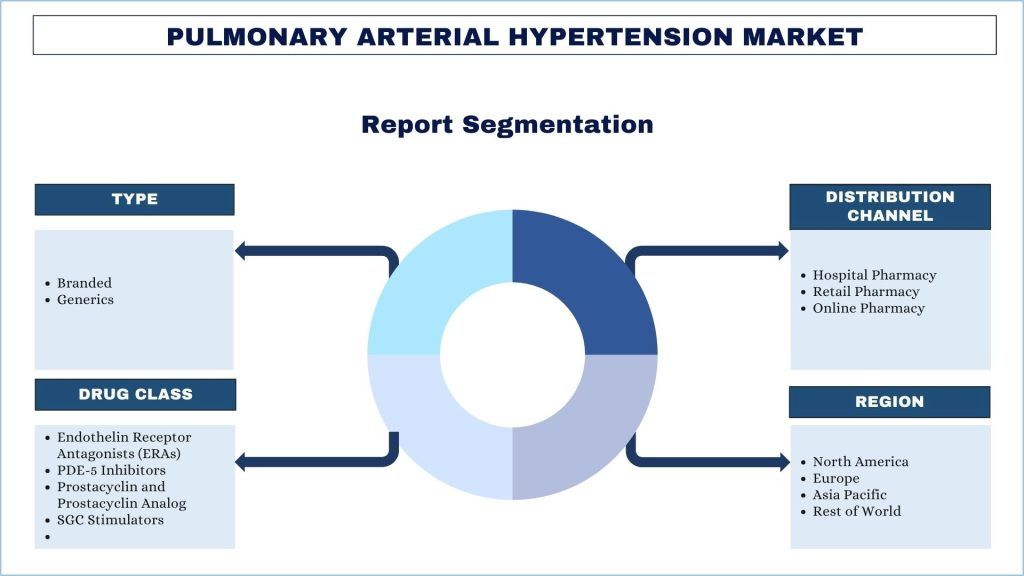
Pulmonary Arterial Hypertension Market Trends
This section discusses the key market trends that are influencing the various segments of the Pulmonary Arterial Hypertension Market as identified by our team of research experts.
Increasing Demand for Innovative Therapeutic Approaches
Advances in drug delivery systems, such as nanoparticle-based delivery and inhalable formulations, are improving the efficacy and safety of PAH treatments. These systems allow for targeted delivery of medications directly to the lungs, enhancing therapeutic outcomes and reducing systemic side effects. Further, emerging gene and cell therapy approaches hold promise for treating PAH at a molecular level. Techniques like gene editing and stem cell therapy aim to repair or replace damaged pulmonary artery cells, offering potential long-term solutions for PAH patients.
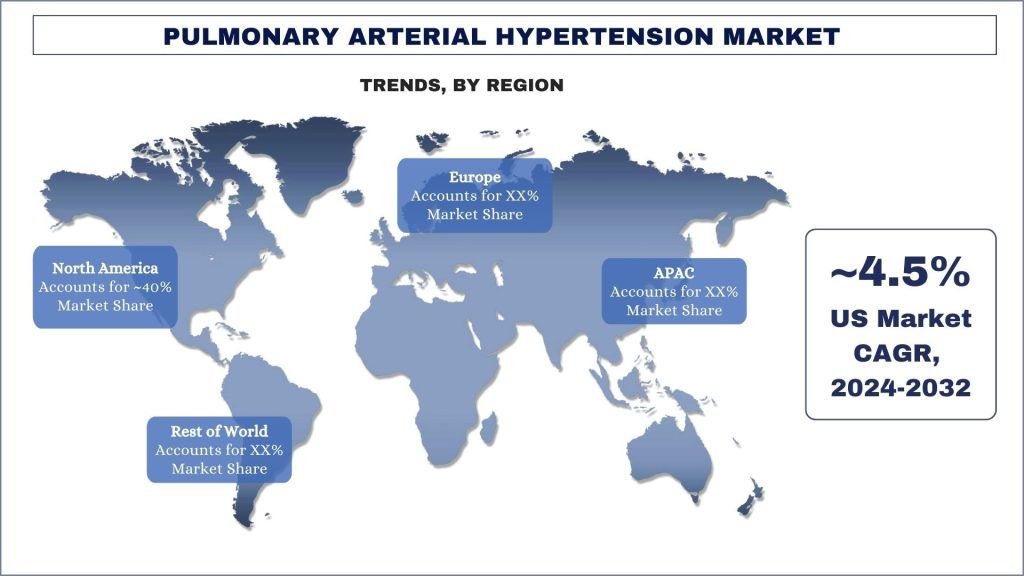
North America is Expected to Grow with Significant CAGR During Forecast Period
The Pulmonary Arterial Hypertension Market in North America has experienced significant growth in recent years, driven by various factors. North America, particularly the U.S., represents one of the largest markets for Pulmonary Arterial Hypertension globally. One of the primary drivers of the Pulmonary Arterial Hypertension Market in North America is the rising cases of PAH and rising adoption of digital and telemedicine. Wearable devices and mobile health applications are enabling continuous remote monitoring of PAH patients. These technologies can track vital signs, physical activity, and symptoms in real time, allowing for early detection of disease exacerbations and timely intervention.
Pulmonary Arterial Hypertension Industry Overview
The Pulmonary Arterial Hypertension Market is competitive, with the presence of several global and international market players. The key players are adopting different growth strategies to enhance their market presence, such as partnerships, agreements, collaborations, new product launches, geographical expansions, and mergers and acquisitions. Some of the major players operating in the market are United Therapeutics Corporation, Bayer AG, Gilead Sciences, Inc., Johnson & Johnson, Viatris Inc., GlaxoSmithKline, Sandoz Inc, Lupin Pharmaceuticals, Inc., Sun Pharmaceutical Industries, Inc., and Teva Pharmaceutical Industries Ltd.
Pulmonary Arterial Hypertension Market Report Coverage
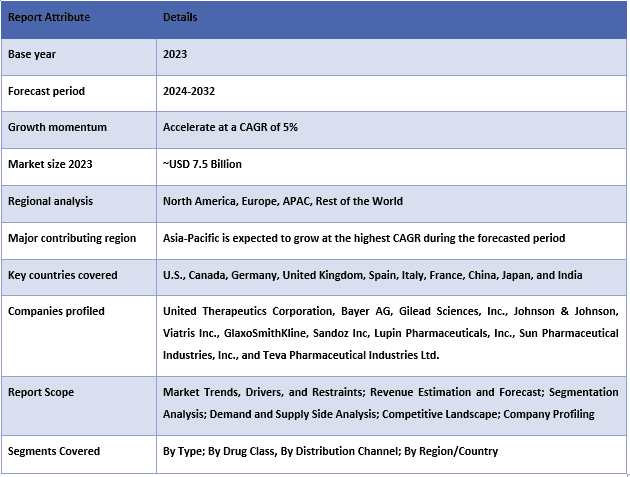
Reasons to buy this report:
- The study includes market sizing and forecasting analysis validated by authenticated key industry experts.
- The report presents a quick review of overall industry performance at one glance.
- The report covers an in-depth analysis of prominent industry peers with a primary focus on key business financials, product portfolios, expansion strategies, and recent developments.
- Detailed examination of drivers, restraints, key trends, and opportunities prevailing in the industry.
- The study comprehensively covers the market across different segments.
- Deep dive regional level analysis of the industry.
Customization Options:
The Global Pulmonary Arterial Hypertension Market can further be customized as per the requirement or any other market segment. Besides this, UMI understands that you may have your own business needs, hence feel free to connect with us to get a report that completely suits your requirements.
Table of Contents
1. Market Introduction
- Market Definitions
- Main Objective
- Stakeholders
- Limitation
2. Research Methodology Or Assumption
- Research Process of the Pulmonary Arterial Hypertension Market
- Research Methodology of the Pulmonary Arterial Hypertension Market
- Respondent Profile
3. Executive Summary
- Industry Synopsis
- Segmental Outlook
- Market Growth Intensity
- Regional Outlook
4. Market Dynamics
- Drivers
- Opportunity
- Restraints
- Trends
- PESTEL Analysis
- Demand Side Analysis
- Supply Side Analysis
- Merger & Acquisition
- Investment Scenario
- Industry Insights: Leading Startups and Their Unique Strategies
5. Pricing Analysis
- Pricing Analysis
6. Global Pulmonary Arterial Hypertension Market Revenue (usd Bn), 2022-2032f
- Global Pulmonary Arterial Hypertension Market Revenue (usd Bn), 2022-2032f
7. Market Segment By Type
- Branded
- Generics
8. Market Segment By Drug Class
- Endothelin Receptor Antagonists (ERAs)
- PDE-5 Inhibitors
- Prostacyclin and Prostacyclin Analog
- SGC Stimulators
9. Market Segment By Distribution Channel
- Hospital Pharmacy
- Retail Pharmacy
- Online Pharmacy
10. Market Insights By Region
- North America
- U.S.
- Canada
- Rest of North America
- Europe
- Germany
- U.K.
- France
- Italy
- Spain
- Rest of Europe
- Asia-Pacific
- China
- Japan
- India
- Rest of Asia Pacific
- Rest of World
- North America
11. Value Chain Analysis
- List of Market Participants
12. Competitive Landscape
- Competition Dashboard
- Competitor Market Positioning Analysis
- Porter Five Forces Analysis
13. Company Profiled
- United Therapeutics Corporation
- Company Overview
- Key Financials
- SWOT Analysis
- Product Portfolio
- Recent Developments
- Bayer AG
- Gilead Sciences, Inc.
- Johnson & Johnson
- Viatris Inc.
- GlaxoSmithKline
- Sandoz Inc
- Lupin Pharmaceuticals, Inc.
- Sun Pharmaceutical Industries, Inc.
- Teva Pharmaceutical Industries Ltd.
- United Therapeutics Corporation
14. Acronyms & Assumption
- Acronyms & Assumption
15. Annexure
- Annexure
Research Methodology for the Pulmonary Arterial Hypertension Market Analysis (2024-2032)
Analyzing the historical market, estimating the current market, and forecasting the future market of the Global Pulmonary Arterial Hypertension Market were the three major steps undertaken to create and analyze the adoption of Pulmonary Arterial Hypertension in major regions globally. Exhaustive secondary research was conducted to collect the historical market numbers and estimate the current market size. Secondly, to validate these insights, numerous findings and assumptions were taken into consideration. Moreover, exhaustive primary interviews were also conducted, with industry experts across the value chain of the global Pulmonary Arterial Hypertension Market. Post assumption and validation of market numbers through primary interviews, we employed a top-down/bottom-up approach to forecasting the complete market size. Thereafter, market breakdown and data triangulation methods were adopted to estimate and analyze the market size of segments and sub-segments of the industry pertains to. Detailed methodology is explained below:
Analysis of Historical Market Size
Step 1: In-Depth Study of Secondary Sources:
Detail secondary study was conducted to obtain the historical market size of the Pulmonary Arterial Hypertension Market through company internal sources such as annual reports & financial statements, performance presentations, press releases, etc., and external sources including journals, news & articles, government publications, competitor publications, sector reports, third-party database, and other credible publications.
Step 2: Market Segmentation:
After obtaining the historical market size of the Pulmonary Arterial Hypertension Market, we conducted a detailed secondary analysis to gather historical market insights and share for different segments & sub-segments for major regions. Major segments are included in the report as Type, Drug Class, Distribution Channel and regions. Further country-level analyses were conducted to evaluate the overall adoption of testing models in that region.
Step 3: Factor Analysis:
After acquiring the historical market size of different segments and sub-segments, we conducted a detailed factor analysis to estimate the current market size of the Pulmonary Arterial Hypertension Market. Further, we conducted factor analysis using dependent and independent variables such as Type, Drug Class, distribution Channel and regions of the Pulmonary Arterial Hypertension Market. A thorough analysis was conducted for demand and supply-side scenarios considering top partnerships, mergers and acquisitions, business expansion, and product launches in the Pulmonary Arterial Hypertension Market sector across the globe.
Current Market Size Estimate & Forecast
Current Market Sizing: Based on actionable insights from the above 3 steps, we arrived at the current market size, key players in the global Pulmonary Arterial Hypertension Market, and market shares of the segments. All the required percentage shares split, and market breakdowns were determined using the above-mentioned secondary approach and were verified through primary interviews.
Estimation & Forecasting: For market estimation and forecast, weights were assigned to different factors including drivers & trends, restraints, and opportunities available for the stakeholders. After analyzing these factors, relevant forecasting techniques i.e., the top-down/bottom-up approach were applied to arrive at the market forecast for 2032 for different segments and sub-segments across the major markets globally. The research methodology adopted to estimate the market size encompasses:
- The industry’s market size, in terms of revenue (USD) and the adoption rate of the Pulmonary Arterial Hypertension Market across the major markets domestically
- All percentage shares, splits, and breakdowns of market segments and sub-segments
- Key players in the Global Pulmonary Arterial Hypertension Market in terms of products offered. Also, the growth strategies adopted by these players to compete in the fast-growing market.
Market Size and Share Validation
Primary Research: In-depth interviews were conducted with the Key Opinion Leaders (KOLs) including Top Level Executives (CXO/VPs, Sales Head, Marketing Head, Operational Head, Regional Head, Country Head, etc.) across major regions. Primary research findings were then summarized, and statistical analysis was performed to prove the stated hypothesis. Inputs from primary research were consolidated with secondary findings, hence turning information into actionable insights.
Split of Primary Participants in Different Regions
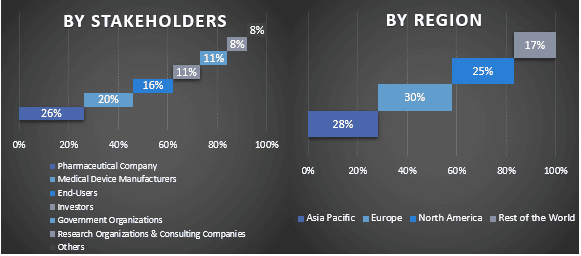
Market Engineering
The data triangulation technique was employed to complete the overall market estimation and to arrive at precise statistical numbers for each segment and sub-segment of the global Pulmonary Arterial Hypertension Market. Data was split into several segments & sub-segments post studying various parameters and trends in the areas of the Type, Drug Class, distribution Channel and regions in the global Pulmonary Arterial Hypertension Market.
The main objective of the Global Pulmonary Arterial Hypertension Market Study
The current & future market trends of the Global Pulmonary Arterial Hypertension Market were pinpointed in the study. Investors can gain strategic insights to base their discretion for investments on the qualitative and quantitative analysis performed in the study. Current and future market trends determined the overall attractiveness of the market at a regional level, providing a platform for the industrial participant to exploit the untapped market to benefit from a first-mover advantage. Other quantitative goals of the studies include:
- Analyze the current and forecast market size of the Pulmonary Arterial Hypertension Market in terms of value (USD). Also, analyze the current and forecast market size of different segments and sub-segments.
- Segments in the study include areas of the Type, Drug Class, distribution Channel and regions.
- Define and analysis of the regulatory framework for the Pulmonary Arterial Hypertension
- Analyze the value chain involved with the presence of various intermediaries, along with analyzing customer and competitor behaviors of the industry.
- Analyze the current and forecast market size of the Pulmonary Arterial Hypertension Market for the major region.
- Major countries of regions studied in the report include Asia Pacific, Europe, North America, and the Rest of the World
- Company profiles of the Pulmonary Arterial Hypertension Market and the growth strategies adopted by the market players to sustain in the fast-growing market.
- Deep dive regional level analysis of the industry
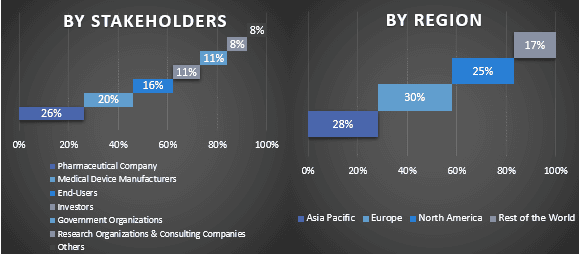
You can also purchase parts of this report. Do you want to check out a section wise
price list?
Frequently Asked Questions FAQs
Q1: What is the Pulmonary Arterial Hypertension market's current market size and growth potential?
Q2: What are the driving factors for the growth of the Pulmonary Arterial Hypertension market?
Q3: Which segment has the largest share of the Pulmonary Arterial Hypertension market by type?
Q4: What are the emerging technologies and trends in the Pulmonary Arterial Hypertension market?
Q5: Which region will dominate the Pulmonary Arterial Hypertension market?
Related Reports
Customers who bought this item also bought






